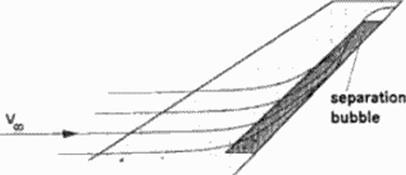Flap Effectiveness
3.5.1 Supersonic hinge lines
At control surfaces with supersonic hinge lines, shocks occur at the hinge line. Shocks produce pressure losses and so reduce flap effectiveness Additionally, the shock can provoke boundary layer separation bubbles (Figure 30); pressure in those bubbles is lower than behind the final shock. This reduces the flap force significantly. Because of the system of the three shocks behaving very sensitive to variations in the incoming flow and to fluctuations in the separation bubble. strong vibration loads can arise
3.5.2 Trailing edge flaps on highly swept wings
On wings with highly swept (subsonic) trailing edges (OFW. arrow wings), the boundary layer is deflected by the spanwise pressure gradients and tends to become nearly parallel to (lie trailing edge, or even separates (Figure 32). Tendencies known from lower sweep angles, and results for very high sweep angles, are not conclusive. Further theoretical and experimental investigations
arc required to understand flap efficiency at relevant sweep angles.
|
Figure 32 Highly Swept Trailing Edge |












